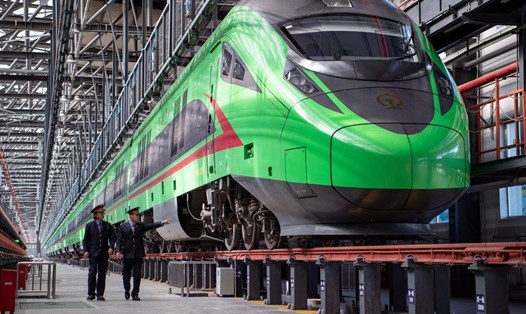SCMP reports that China's 1,000km/h bullet train will support 5G. Passengers can watch extremely high-end videos or play games on their smartphones while traveling at a speed of 1,000 km/h.
Still in development, China's new generation of bullet trains can travel faster than commercial aircraft through near-vacuum tubes using magnetic buffer forces.
Currently, Chinese bullet trains operate at speeds of 350 km/h and can connect to 5G services provided by telecom operators, maintaining connections even in long tunnels.
However, maintaining high-speed communication between mobile phones and base stations becomes extremely difficult at near-acute speeds.
The reason is that when the phone quickly approaches or moves away from the base station, the signal frequency that the phone receives will change and the high-speed data transmission depends heavily on stable high-speed signals.
The installation and maintenance of base stations in near-vacuum tubes is also very difficult. If the antler falls off due to vibration, it can pose a serious threat to a fast-moving train.
A research team led by Professor Song Tiecheng at the National Key laboratory of Mobile Communications at Southeast University discovered that simply placing two parallel cables on the inner wall of the tube can solve the problem of installing a base station.
These special cables can "leak" electromagnetic signals and establish a continuous and stable connection between smartphones and mobile service providers.
By using effective encryption techniques and adjusting some key signal parameters, the interference caused by frequency changes can be further overcome. Initial computer simulations have verified that this method can maintain stable communication quality during data exchange according to official 5G standards.
Engineers from the China Aerospace Science and Technology Corporation participated in the study. The group has built the world's largest research facility on vacuum tube gaskmate buffer ships in Dai Dong, Son Tay province and begun testing high-speed propulsion systems on large-scale prototype vehicles.
Currently, many Chinese cities are seeking approval from Beijing to build the first commercial vacuum tube bullet train route.
This revolutionary method of ground transportation - also known as hyperloop - was first proposed by Elon Musk, founder of SpaceX. Similar technologies could also be used to propel spacecraft into space at a lower cost.
But Elon Musk abandoned the project late last year due to technological and financial challenges. This makes China the only country currently developing this technology.











